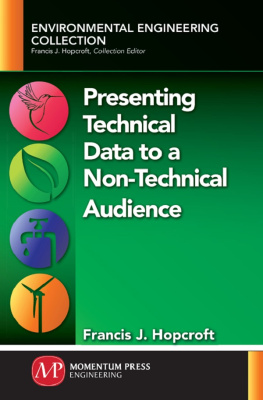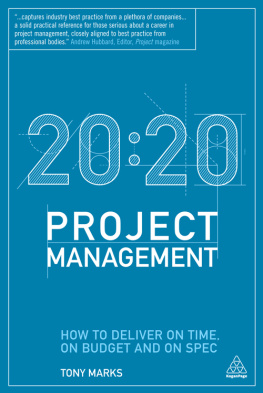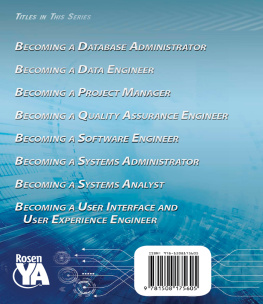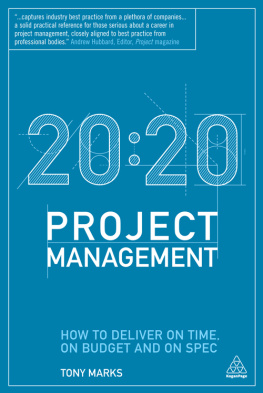

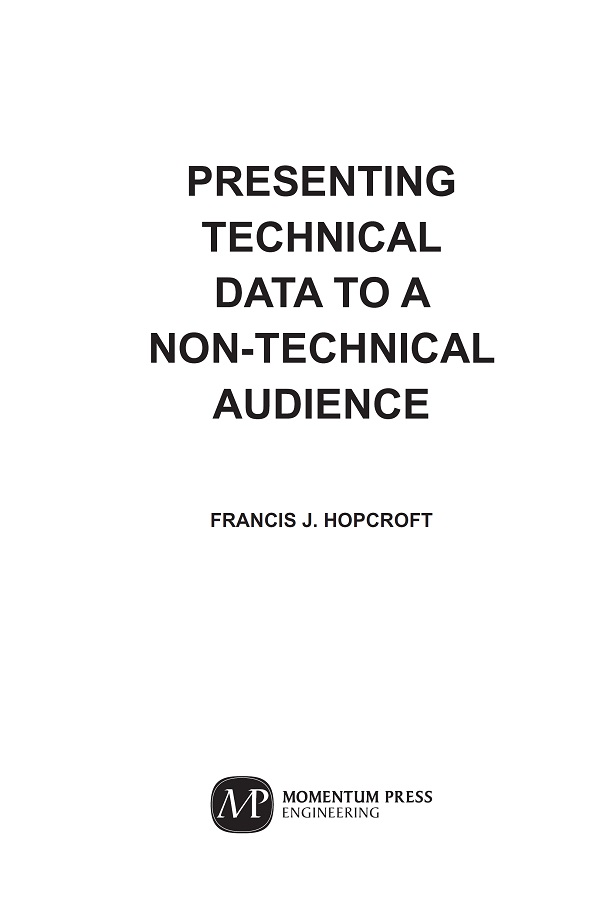
Presenting Technical Data to a Non-technical Audience
Copyright Momentum Press, LLC, 2019.
All rights reserved. No part of this publication may be reproduced, stored in a retrieval system, or transmitted in any form or by any meanselectronic, mechanical, photocopy, recording, or any otherexcept for brief quotations, not to exceed 250 words, without the prior permission of the publisher.
First published in 2019 by
Momentum Press, LLC
222 East 46th Street, New York, NY 10017
www.momentumpress.net
ISBN-13: 978-1-94944-932-7 (print)
ISBN-13: 978-1-94944-933-4 (e-book)
Momentum Press Environmental Engineering Collection
Collection ISSN: 2375-3625 (print)
Collection ISSN: 2375-3633 (electronic)
Cover and interior design by S4Carlisle Publishing Services Private Ltd., Chennai, India
First edition: 2019
10 9 8 7 6 5 4 3 2 1
Printed in the United States of America
ABSTRACT
The presentation of technical data is both an art form and a necessary part of any engineers job. Most engineers are not anywhere near as conversant with the tools or nuances of presenting technical data, particularly to an audience of nontechnical persons, such as at a public meeting, a meeting of a board of selectmen or aldermen, or at a city council, for example. While it is vitally important to be conversant with the technical details and background of the data being presented, it is equally as important to be able to make the presentation as cogent and valuable to the viewer as possible. This book addresses many of the failings of technical presentations observed by the authors over many years of practice. While not proffered as an exhaustive dissertation of all possible issue or problems, this book does touch upon the most important aspects of technical presentations and the most common errors made while making those presentations.
KEYWORDS
nontechnical audiences; presentation techniques; presenting technical data; technical presentations
CONTENTS
The assistance of Ms. Joey Engling with helping me to calculate and understand the intricacies of the statistical equivalencies in

One of the more important things that engineers are called upon to do as professionals is to present information of a highly technical nature to non-technical audiences. How well that is done can make or break a career. This is true for all specialties in engineering and indeed for all professionals.
On their face, those two conceptstechnical data and non-technical audiencessound, at the same time, both onerous and ridiculous. But careful consideration of the ways that engineers interact with clients and the general public will show that they are both quite accurate in their clarity and substance. Engineers are the key to everything people do, from the infrastructure that supports the buildings in which people work to the buildings and the furnishings, the equipment and the outcomes. Without good engineering, nothing lasting will be built or manufactured.
Engineers are called upon to develop data during the analysis of problems to be solved, to analyze those data accurately, to present various interpretations of those data, to discuss different interpretations of the data, and to successfully argue for the implementation of recommended options or alternatives. The engineer generates the data from which the client makes a decision and then implements the clients decision.
The client to whom the engineer is presenting data and analyses may be technically competent, not technically competent, or a mix of stakeholders who have various degrees of competence in the technical areas under discussion. The presentation needs to be tailored to meet the expectations and competence of the audience at hand. The technically competent audience usually does not want to hear about the theory behind the science; only an identification of the methodology used, the results of the analyses, and the recommendation of the engineer. The non-technical audience needs to understand the basic concepts behind the science used and the justification for the use of that specific analytical technique before they try to understand the results of the analyses. The mixed audience needs some understanding of the science, but not as much as a non-technical audience does and much less than a technical audience. The key is to keep everyone involved and on board with the discussion at all times.
How the engineer presents the data at the outset can have a significant, and expensive, impact on the decision made by the client. This book describes some of the more common issues and errors made when presenting data, particularly to a non-technical audience, and how to overcome those conceptual issues.

There are certainly lots of ways to present data. Tables are good examples of how large sets of numerical data are organized and presented. An example of such a data set is the environmental data collected over long periods of time from the groundwater quality monitoring of a contaminated site. Typically, monitoring will occur at several monitoring wells on a site as frequently as monthly for several years. A site with 14 or 15, or more, monitoring wells, monitored monthly for, say 5 years, with each sample being tested for 15 to 20 contaminants, will yield a data set of perhaps 10,000 to 15,000 data points. In addition, a column or row with the regulatory standard for each of the data points is needed that includes each of the contaminants for which tests were conducted at the site. A table presenting those data would typically be done on a spreadsheet of approximately 20 to 50 columns and several hundred rows. It is not realistic to consider printing a data set of that magnitude on a single sheet of paper, and if it were done, it would be totally illegible.
Moreover, if the data were presented on a series of sheets of paper, the number of data points that violate the standards, versus those that do not, would be difficult to discern. If the engineer were to highlight the violations, they could be found on the spreadsheet more easily, but recognizing a pattern of improvement or degeneration over an extended time frame, or seeing the changes in the concentrations of degradation by-products or contaminant reduction over time, would become extremely difficult.
Presenting data, particularly large or very large data sets, on a time line, as a visual, can be much more effective. The concept is to present as much information as possible, in the smallest amount of space, with maximum clarity, for both the technical audience and the non-technical audience. This concept is illustrated by shows a large data set (40 columns by 118 rows) generated at a now-closed remediation site. It will not be possible to easily read those data from the chart because the font size is necessarily so small to fit the page that reading it becomes impossible. Notice that this chart is reduced to a font size of 4, and it still requires over 3 pages to print. The data points that violate the concentration standards are highlighted in this chart, but that does not help a lot when the data set takes more than three pages to print.
Next page
